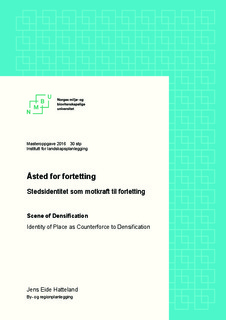| dc.contributor.advisor | Skog, Kristine Lien | |
| dc.contributor.advisor | Grønning, Marius | |
| dc.contributor.author | Hatteland, Jens Eide | |
| dc.date.accessioned | 2016-08-24T12:57:52Z | |
| dc.date.available | 2016-08-24T12:57:52Z | |
| dc.date.issued | 2016-08-24 | |
| dc.identifier.uri | http://hdl.handle.net/11250/2401485 | |
| dc.description.abstract | Bærum er en av flere kommuner i hovedstadsregionen som er utpekt til å ta en vesentlig del av
den forventede befolkningsveksten de kommende årene. Dermed må kommunene legge til rette
for utbygging og vekst i tråd med nasjonale retningslinjer for fortetting og kompakt byutvikling.
På tross av tydelige retningslinjer er det flere eksempler over hele landet på kommuner som ikke
klarer å oppfylle disse.
Tema for oppgaven er motkrefter til fortetting og problemstillingen tar for seg i hvilken grad
stedsidentitet kan være en motkraft til fortetting. For å svare på dette vil det belyses hvilke
kvaliteter som vektlegges blant innbyggerne og hvordan dette påvirker arealplanleggingen.
For å svare på problemstillingen er det gjennomført forstudium, historisk analyse,
dokumentanalyse, dybdeintervju og spørreundersøkelse. Funnene er koblet mot stedsteori og
teori knyttet til urban sprawl. Det er også lagt vekt på det historiske perspektivet for å forstå
hvordan identitet kan ha utviklet seg over tid.
Studien viser at Bærums utvikling har vært preget av et forstadsideal. Natur og landskap samt
fellesskap i lokalsamfunn verdsettes som de fremste kvalitetene både i Bærum generelt og av
lokalbefolkningen på Gjønnes. Motstanden til fortetting i Bærum dreier seg hovedsakelig om
motvilje til å endre de fysiske forholdene og eksisterende strukturer, i følge denne studien kan
motstanden være dypere forankret i menneskers sosiale identitet fordi mennesker og steder
utvikler identitet i samsvar med hverandre. Hvordan man oppfatter Bærum og Gjønnes påvirker
dermed hvordan man oppfatter seg selv. Det knyttes identitet til betydningen av de fysiske
omgivelsene og fellesskap i lokalsamfunn. Fortettinger i Bærum oppfattes ikke i tråd med den
betydningen lokalbefolkningen vektlegger og utviklingen er dermed i konflikt med forståelsen av
seg selv.
Det konkluderes med at stedsidentitet kan utgjøre en betydelig motkraft til fortetting. Imidlertid
kan stedsidentitet fungere som en del av et større bilde og hvilken betydning man tillegger sted er
individuelt og vil variere fra person til person. | nb_NO |
| dc.description.abstract | Bærum is one of several municipalities in the Oslo region which is designated to take a substantial
part of the expected population growth in the coming years. Thus, the municipalities must
facilitate the development and growth in line with national guidelines for densification and
compact development. Despite clear guidelines there are several examples across the country on
municipalities that fail to meet these.
The topic is counterforces to densification and the research question examines the extent to
which identity of place can be a counterforce to densification. To answer this, it looks at the
qualities that are emphasized among the citizens and how this affects land use planning.
To answer the research question it is carried out preliminary study, historical analysis,
document analysis, in-depth interviews and survey. The findings are linked to theory about the
phenomenological concept of place and theory related to urban sprawl. It is also emphasized the
historical perspective to understand how identity of place may have evolved over time.
The study shows that Bærums development has been marked by a suburban ideal. Natural
landscape and community in communities valued as the foremost qualities both in Bærum in
general and at Gjønnes. Opposition to densification in Bærum concerns primarily the reluctance
to change the physical conditions and existing structures, according to this study, the resistance
may be deeper rooted in human social identity because people and places develops identity
consistent with each other. It tied identity to the importance of the physical environment and
community in local communities. Densification in Bærum perceived not in keeping with the
importance locals emphasize and development is thus in conflict with the understanding of
oneself.
It is concluded that identity of place can constitute a significant counterforce to densification.
However, local identity function as part of a larger picture and what significance they attach to
place individually and will vary from person to person. | nb_NO |
| dc.language | Norwegian University of Life Sciences, Ås | |
| dc.language.iso | nob | nb_NO |
| dc.subject | sted | nb_NO |
| dc.subject | stedsidentitet | nb_NO |
| dc.subject | sense of place | nb_NO |
| dc.subject | territorialisering | nb_NO |
| dc.subject | urban sprawl | nb_NO |
| dc.subject | forstad | nb_NO |
| dc.subject | motkraft | nb_NO |
| dc.subject | fortetting | nb_NO |
| dc.subject | kompakt byutvikling | nb_NO |
| dc.subject | Bærum | nb_NO |
| dc.subject | Gjønnes | nb_NO |
| dc.title | Åsted for fortetting : stedsidentitet som motkraft til fortetting | nb_NO |
| dc.title.alternative | Scene of Densification: Identity of Place as Counterforce to Densification | nb_NO |
| dc.type | Master thesis | nb_NO |
| dc.subject.nsi | VDP::Social science: 200::Urbanism and physical planning: 230::Planning history, planning theory and planning methodology: 231 | nb_NO |
| dc.subject.nsi | VDP::Social science: 200::Urbanism and physical planning: 230::Landscape planning: 236 | nb_NO |
| dc.subject.nsi | VDP::Social science: 200::Urbanism and physical planning: 230::Spatial, territorial planning: 238 | nb_NO |
| dc.source.pagenumber | 76 | nb_NO |
| dc.description.localcode | M-BYREG | nb_NO |
